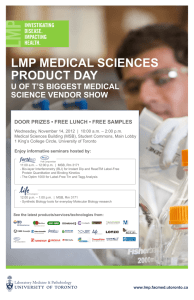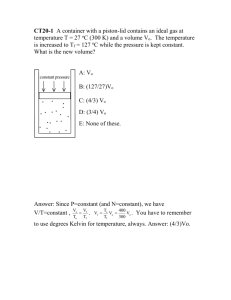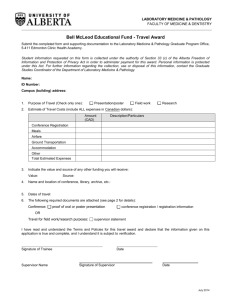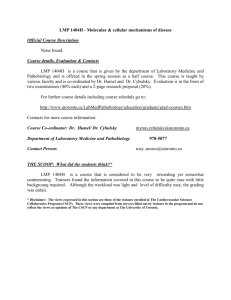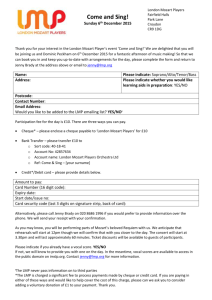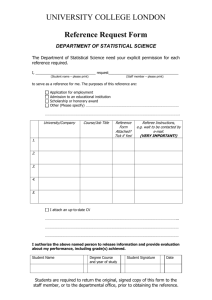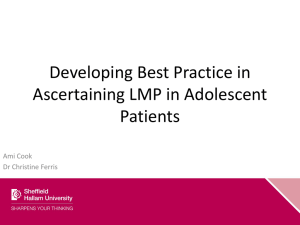External Review Report - Laboratory Medicine and Pathobiology
advertisement
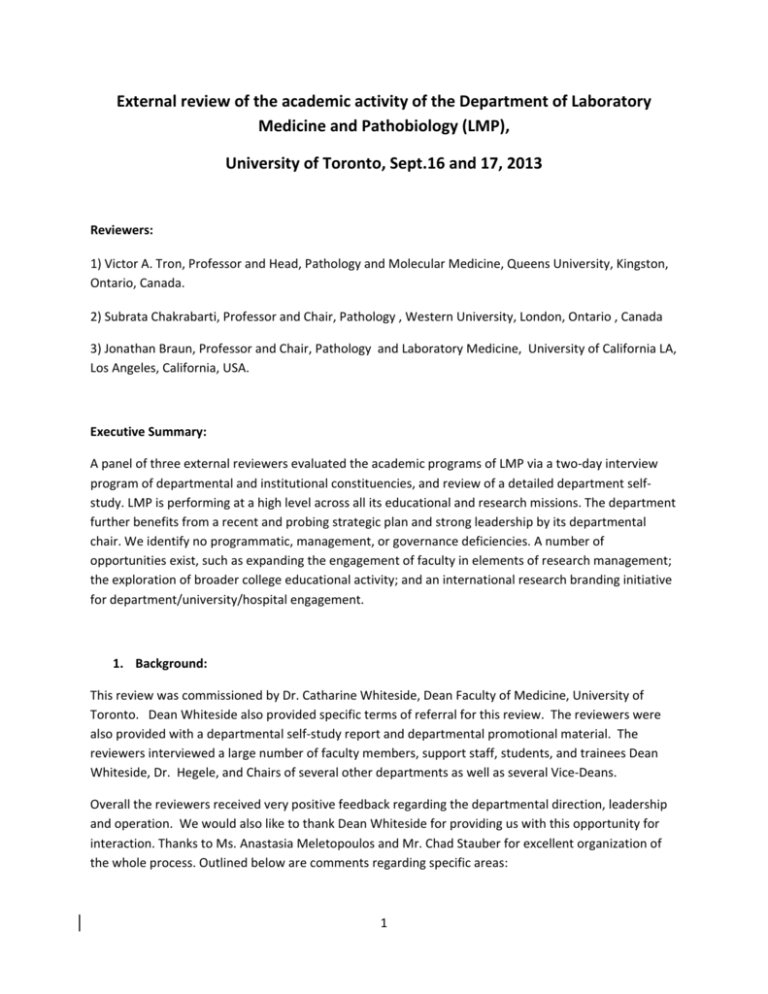
External review of the academic activity of the Department of Laboratory Medicine and Pathobiology (LMP), University of Toronto, Sept.16 and 17, 2013 Reviewers: 1) Victor A. Tron, Professor and Head, Pathology and Molecular Medicine, Queens University, Kingston, Ontario, Canada. 2) Subrata Chakrabarti, Professor and Chair, Pathology , Western University, London, Ontario , Canada 3) Jonathan Braun, Professor and Chair, Pathology and Laboratory Medicine, University of California LA, Los Angeles, California, USA. Executive Summary: A panel of three external reviewers evaluated the academic programs of LMP via a two‐day interview program of departmental and institutional constituencies, and review of a detailed department self‐ study. LMP is performing at a high level across all its educational and research missions. The department further benefits from a recent and probing strategic plan and strong leadership by its departmental chair. We identify no programmatic, management, or governance deficiencies. A number of opportunities exist, such as expanding the engagement of faculty in elements of research management; the exploration of broader college educational activity; and an international research branding initiative for department/university/hospital engagement. 1. Background: This review was commissioned by Dr. Catharine Whiteside, Dean Faculty of Medicine, University of Toronto. Dean Whiteside also provided specific terms of referral for this review. The reviewers were also provided with a departmental self‐study report and departmental promotional material. The reviewers interviewed a large number of faculty members, support staff, students, and trainees Dean Whiteside, Dr. Hegele, and Chairs of several other departments as well as several Vice‐Deans. Overall the reviewers received very positive feedback regarding the departmental direction, leadership and operation. We would also like to thank Dean Whiteside for providing us with this opportunity for interaction. Thanks to Ms. Anastasia Meletopoulos and Mr. Chad Stauber for excellent organization of the whole process. Outlined below are comments regarding specific areas: 1 2. Education‐ Degree programs: 1) Undergraduate Life Science Program – BSc, Faculty of Arts & Science A. Objectives: This program is provided through the Faculty of Arts and Sciences. This introduces undergraduate students to LMP. The program is consistent with the University’s mission and the Faculty’s and Unit’s academic plans. B. Admission: Admission requirements are appropriate to the learning outcome of the program. C. Curriculum & Program Delivery: Well‐structured and appropriate. The program also provides the students with opportunities of learning beyond the classroom, including research engagement. D. Assessment of Learning: Well‐structured and appropriate. E. Quality Indicator: This program recruits high caliber students, who are enthusiastic learners and receive a high level of education. Specific comments: Prof. Doug Templeton has provided exemplary leadership in running this program by its coherence and accompanying quality indicator. However, the program has been at a small scale (target of 30), and even enrollment target has not been met. Achieving and expanding the program beyond this target is important for its sustainability, and as a pipeline for other departmental goals (e.g., recruitment of a larger number of high quality graduate students). Although there are some concerns by faculty that such a step may lead to dilution of program quality, we endorse an initiative to increase enrollment , assessed by outcome metrics (e.g., curricular impact, student quality, and salary revenue). 2) Graduate Education A. Objectives: LMP graduate program is one of the largest graduate programs in the University. The program is consistent with the University’s mission and Faculty and Unit’s academic plans B. Admission: Admission requirements are appropriate to the learning outcome of the program. C. Curriculum & Program Delivery: Well‐structured and appropriate. The program primarily provides the students with opportunities for research engagement. D. Assessment of Learning: Well‐structured and appropriate. E. Quality Indicator: This program recruits high caliber students, who are enthusiastic learners and receive high level of education. The graduates show excellent placement records. Specific comments: The program is very well run. The program director Dr. Harry Elsholtz has, over the years, demonstrated excellent leadership in this area. The program will further benefit if all faculty members are regularly made aware of the various processes and procedures and there is engagement of more faculty members in the management of the program. As international students have to pay a significant differential fee, the requirement for concordantly increased stipend support by supervisors limits the number of faculty who are able to take international students. A mechanism, in discussion with Faculty of Graduate Studies, may help to address such issues. In addition reduced research grant funding may pose additional pressure on this program. The Department should explore establishing a 2 `rainy day funds’ for such circumstances. This management exploration should be done with involvement of the research faculty, to benefit from their ideas, and reciprocally, to educate them on feasibilities with respect to department budget, university wherewithal, and policy. 3) Undergraduate Medical Education A. Objectives: LMP provides undergraduate medical education. The program is consistent with the University’s mission and Faculty’s and Unit’s academic plans. B. Admission: Admission requirements are appropriate to the learning outcome of the program. C. Curriculum & Program Delivery: Well‐structured and appropriate. D. Assessment of Learning: Well‐structured and appropriate. E. Quality Indicator: This program runs as a part of the medical education through undergraduate medical office. The graduates show excellent placement records. Specific comments: The program is very well run; however, as in the undergraduate medical education curriculum numbers of lecture hours are diminishing, the exposure of medical students to pathology and subsequent recruitment in pathology residency program may also reduce. The department may consider increasing elective and selective offering and may also combine such offering with other dept (eg. surgery or gastroenterology). Such an approach will also increase undergraduate teaching hours (required for promotion) for hospital‐based faculty. 4) Continuing Education A. Objectives: LMP provides continuing medical education for its own faculty as well as for the community. The program is consistent with the University’s mission and Faculty’s and Unit’s academic plans. B. Admission: Admission requirements are appropriate to the learning outcome of the program C. Curriculum & Program Delivery: Well‐structured and appropriate. D. Assessment of Learning: Well‐structured and appropriate. E. Quality Indicator: This program runs as a part of the Continuing Professional Development Office. Specific comments: Continuing education program may further be expanded with use of new technology. Such process may also be useful for international expansion. 5) Postgraduate Medical Education A. Objectives: LMP provides the largest post graduate education program in this discipline in the country. LMP Residency Training Programs are offered in Anatomical Pathology, Hematological Pathology, Medical Microbiology, Neuropathology and Forensic Pathology. 3 B. C. D. E. The program is consistent with the University’s mission and the Faculty’s and Unit’s academic plans. Admission: Admission is done through the CARMS matching program. Admission requirements are appropriate to the learning outcome of the program Curriculum & Program Delivery: Well‐structured and appropriate and designed according to Royal College guidelines. Assessment of Learning: Well‐structured and appropriate and designed according to Royal College guidelines. Quality Indicator: Postgraduate Medical Education program runs through Post‐Graduate Medical Education Office. The graduates show excellent placement records. Specific comments: From the input received from postgraduate medical trainees (Residents) in anatomical pathology, there are some concerns regarding availability of autopsy resources. This is especially important as there is reduced number of hospital autopsies combined with rotation of off‐ service residents and residency program in forensic pathology. The forensic unit in Toronto is known to provide excellent basic training in autopsy technique, and can provide a very good volume of cases for residency training. This is not an easy challenge; however, careful attention is required. 6) Postgraduate Diploma Program F. Objectives: LMP provides excellent post graduate diploma programs in Clinical Chemistry and Clinical Microbiology. The programs are consistent with the University’s mission and the Faculty’s and Unit’s academic plans. G. Admission: Admission is done directly. H. Curriculum & Program Delivery: Well‐structured and appropriate and designed according to specific professional societies guidelines. I. Assessment of Learning: Well‐structured and appropriate and designed according to professional society’s guidelines. Quality Indicator: Postgraduate diploma program runs through Post‐Graduate Medical Education office. The graduates show excellent placement records. 3: Research: The Research that occurs in LMP is of high caliber. The faculty members are committed, and the quality and quantity of the research is comparable to international standard. LMP had strategic planning and focused its departmental research directions. One such direction is translational research. The department has created a position of a research director and trying to stimulate interactions among researchers. The major challenge is potential pressure on research funding. Although such pressure is not acute, as the departmental researchers recognized, such possibilities cannot be ignored. This is especially true 4 due to changing CIHR funding model which remains a mystery. Furthermore hospital based pathologists may be encouraged to take a leading role in translational research. The department may consider making a plan to support specific researchers if they lose their grants. Furthermore the departmental translational research agenda can be moved forward with increased interaction with U of T based researchers, Hospital based researchers and pathologists. Such interactions may be stimulated using inter‐institutional rounds, research seminars etc. Use of videoconferencing may also be considered to save on travel time. 4. Relationships: Faculty, students and staff are very positive about their experience in LMP. Overall the relationship is collegial and nurturing. Students at all levels enjoy their LMP experience. The support staff spoke very highly of the organization and the team spirit. Majority of the pathologists and scientists are happy with the relationship. This is also reflected in the recent survey conducted by LMP. LMP has built excellent relationship with other university departments (Surgery, Medicine, Head and Neck, Genetics) and hospital research institutes. These relationships may be further utilized to have jointly –appointed scientists to move the translational research agenda. There are some challenges regarding the interactions with hospitals. LMP should try to take steps towards developing some unified approach to emphasize to faculty the importance of academic activities. Small steps such as implementation of city‐wide academic rounds may be considered an initial move towards this direction. Increased interaction of U of T with hospital based pathologists and scientists and engaging pathologists and scientists in university affairs will be a win‐win situation and may be instrumental to move LMP’s strategic priorities forward. One potential unifying role that LMP could take is to work with hospitals to develop alternate payment plans for pathology medical groups. This direction could emphasize the importance of all the required elements of an academic practice and give a sense of ownership/professionalism to the faculty. Defined deliverables would provide the needed accountability to make such a direction acceptable to government and hospital administrations. This is a direction that the OMA section on Laboratory Medicine negotiation is taking. Furthermore, this would be in line with other medical groups, such as surgery and medicine. We understand that the group at Sunnybrook currently has a partnership model. 5. Organization and Financial Structure: In general, the department is well organized; however, due to the complexity of the department and a complex relationship with large hospitals and research institutes, there may be a challenge in resource allocation to perform academic mandates of LMP. Open discussion with hospital and research institutes are encouraged. Detailed analyses of the financial or the organizational infrastructure is, however, beyond the scope of this review. 6. Long Range Planning Challenges: 5 LMP has clearly articulated its strategic plans; hence, the departmental goals and visions are clearly identified. Dr. Hegele has communicated and managed through these strategic plans, yielding excellent leadership during the review period. This view is further shared by the majority of students, faculty and staff, and other departmental leadership; however, to achieve its strategic agenda, expanded space and research infrastructure may be an issue. 7. National and International Comparators: Overall, LMP is a department within the U of T that definitely stands above other Canadian universities. Internationally, LMP remains a major player. The department may also look at the branding. Although this may be a difficult and sensitive issue, aligning all research (regardless of the specific sites, where they were performed) with LMP‐ U of T may have an added advantage to raise departmental, hospital and university profiles internationally. 8. Response to Previous Reviews: The department has adequately addressed the issue raised by the previous reviewers. The leadership has taken the reviewers’ comments very seriously and has focused on specific areas (eg. translational research). 9. Conclusion: Overall LMP is on a solid footing with clear strategy and vision. The leadership is excellent, and the department, we believe, is moving in the right direction; however, there is always room for improvement. We have mentioned some of these in specific areas. We would like to iterate that some of the challenges are indeed shared responsibilities. The departmental leadership, faculty, and staff at all levels have to work together to make these happen. 6
